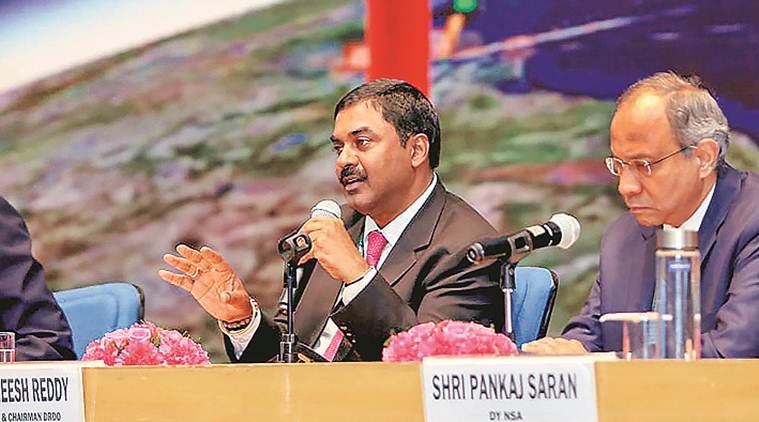
The Defence Research and Development Organisation (DRDO) on Saturday held a detailed briefing on India’s Anti-Satellite Test (A-SAT), defending both its timing and the government revealing it to the world.
Asked whether the DRDO had the permission of the Election Commission (EC) for the briefing, officials said they had the “necessary clearance”.
Amidst the Opposition going to the EC over the test, and Prime Minister Narendra Modi himself announcing it to the nation, DRDO Chairman G Satheesh Reddy gave a detailed representation on ‘Mission Shakti’, with graphics. Addressing a packed auditorium here, he said the timing of the test was “technologically and scientifically driven” and said tests of this nature couldn’t be kept a secret. He also ruled out any future A-SAT missile tests in the lower Earth orbit by India, saying these were not needed any more.
Reddy said India had chosen an orbit of less than 300 km for Mission Shakti for “capability demonstration” and to avoid threat of debris to global space assets. “The chosen orbit was nearly 120 km below the International Space Station (ISS) orbit. There was no possibility of hitting the ISS with A-SAT debris. Even NASA spoke about a 10-day risk period that is over today,” Reddy said, adding that their radars had spotted the debris after the test and these would dissolve within 45 days.
On Tuesday, the US space agency had termed India shooting down a satellite, one of its own, a “terrible thing” saying the mission had created about 400 pieces of orbital debris which posed a threat to the ISS.
However, NASA appears to have climbed down since. In a letter to ISRO Chairman K Sivan sent on April 4, as reported by PTI from Washington on Saturday, NASA Administrator James Bridenstine said that “based on the guidance received from the White House”, he looked forward to continuing to work with ISRO on a host of issues, including human space flights.
It was Bridenstine who had attacked India over the test. In his letter, which PTI said it had seen, Bridenstine added, “As we made clear, space debris is a serious issue for the United States. As it is a growing threat, it is the responsibility of all nations who operate in space… We will continue to monitor the remaining debris from your test as it relates to the safety of our human spaceflight activities especially at the International Space Station.”
Also read | Rajnath Singh’s missile flexing: Can ward off big superpowers
The DRDO’s presentation came amidst the Opposition’s complaint to the EC over Modi’s address to the nation on A-SAT, saying it violated the poll code of conduct. The EC, however, had given the PM a clean chit on the issue.
Reddy said Saturday, “A mission of this nature after a test is conducted can’t be kept a secret. A satellite is tracked by many stations across the world.”
Also read | NASA says cooperation with ISRO remains intact
Asked when the DRDO had got the nod for the project, Reddy said the first discussion on A-SAT started in 2014 and the formal detailed presentation was made in 2016. “After the formal approvals in 2016, we started work on this project.”
Mission planning involved extensive simulation to ensure no damage due to debris, he said, adding that the high risk period of the first 10 days got over on Saturday.
He added that the interceptor developed by India had the capability to intercept satellites up to an orbit of 1,000 km. “An orbit of around 300 km was chosen for the test… The debris created following the intercept will decay in 45 days. Debris won’t cause a problem to any existing space asset. We have some amount of mechanism to look at these objects. In fact, our radars picked up the debris immediately after the test.”
Explained | The ABC of India’s anti-satellite missile test
Lauding the DRDO for the sucess of ‘Mission Shakti’, Reddy said, “Space has gained importance in military domain. When a country like India has done an exercise like this and shown capability of interception of a target, you have shown capability for such operations. The best way of defence is to have deterrence.”
Asked about weaponisation of space, the DRDO Chairman said it is a decision the government had to make. “If a space command and centre needs to be formulated, it is the decision of the government.”
More than 150 scientists had taken part in the mission and around 40 of them were women, the DRDO said.
On March 27, the PM had announced that India had entered the elite club of nations to possess the capability to hit a target in space, saying the other countries with such a capability are the US, Russia and China.
Addressing a town hall meeting on April 1, NASA chief Bridenstine had questioned India’s A-SAT mission, saying, “it is a terrible, terrible thing to create an event that sends debris and an apogee that goes above the International Space Station”.
In his letter to ISRO on April 4, Bridenstine wrote, “Recently, we sent you a letter indicating a suspension of activities under the NASA-ISRO Human Space Flight Working Group… As part of our partnership with you, we will continue to work on issues using the NASA-ISRO Human Space Flight Working Group, Planetary Science Working Group, US India Earth Science Working Group and the Heliophysics Working Group.”